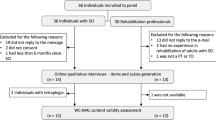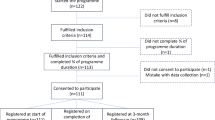Abstract
Study design:
Cross-sectional.
Objectives:
To describe self-identified indoor and outdoor wheelchair-oriented participation outcomes and to report satisfaction with the identified outcomes by people with spinal cord injury (SCI).
Setting:
Vancouver, British Columbia.
Methods:
Participation outcomes were identified using the Wheelchair Outcome Measure and classified using the International Classification of Functioning, Disability, and Health (ICF).
Results:
The average age of the 51 community-dwelling subjects with SCI was 43.7(±10.7) years. Of them, 84% were men, 64% had tetraplegia and 66% used a manual wheelchair. There were 258 indoor and 257 outdoor participation outcomes identified by this sample with most outcomes falling into the ‘community, social, and civil life’ (36.5%), ‘domestic life’ (23.7%) and ‘mobility’ (18%) domains of the ICF. All domains had a mean satisfaction score of 7.1/10 or greater except for the indoor ‘mobility’ domain that had a mean satisfaction score of 6.1/10. Satisfaction scores with performance of the specific participation outcomes ranged from high (10/10) to low (2/10) with most scores falling above 7/10.
Conclusion:
Community-dwelling people with SCI commonly engage in wheelchair-oriented participation outcomes related to ‘community, social, and civil life’, ‘domestic life’ and ‘mobility’ and tend to be satisfied with their performance of these participation outcomes. This information is useful for clinicians and may help to guide assessment and intervention.
Similar content being viewed by others
Log in or create a free account to read this content
Gain free access to this article, as well as selected content from this journal and more on nature.com
or
References
Boschen KA, Miller WC, Noreau L, Wolfe DL, McColl MA, Martin Ginis KA et al. Community reintegration following spinal cord injury. In: Eng J, Teasell RW, Miller WC, Wolfe DL, Townson AF, Hsieh JTC (eds). Spinal Cord Injury Rehabilitation Evidence, Vol 2.0. ICORD: Vancouver, BC, 2008: 4-1-4-66.
Noreau L, Fougeyrollas P . Long-term consequences of spinal cord injury on social participation: the occurrence of handicap situations. Disabil Rehabil 2000; 22: 170–180.
Lund ML, Nordlund A, Nygard L, Lexell J, Bernspang B . Perceptions of participation and predictors of perceived problems with participation in persons with spinal cord injury. J Rehabil Med 2005; 37: 3–8.
Cardol M, de Jong BA, van den Bos GA, Beelem A, de Groot IJ, de Haan RJ . Beyond disability: perceived participation in people with a chronic disabling condition. Clin Rehabil 2002; 16: 27–35.
Noreau L, Fougeyrollas P, Post M, Asano M . Participation after spinal cord injury: the evolution of conceptualization and measurement. J Neurol Phys Ther 2005; 29: 147–156.
Hammel J, Magasi S, Heinemann A, Whiteneck G, Bogner J, Rodriguez E . What does participation mean? An insider perspective from people with disabilities. Disabil Rehabil 2008; 30: 1445–1460.
Xu G, Meyer JS, Thornby J, Chowdhury M, Quach M . Screening for mild cognitive impairment (MCI) utilizing combined mini-mental-cognitive capacity examinations for identifying dementia prodromes. Int J Geriatr Psychiatry 2002; 17: 1027–1033.
Miller WC, Mortenson W, Miller F . The WhOM: The Wheelchair Outcome Measure: Manual. Version 2 2007.
Garden J, Miller W, Mortenson W . Reliability and validity of the Wheelchair Outcome Measure (WhOM). The 22nd International Seating Symposium: 2006 March 2–4. Vancouver, BC, 2006.
Demers L, Weiss-Lambrou R, Ska B . Development of the Quebec User Evaluation of Satisfaction with assistive Technology (QUEST). Asst Technol 1996; 8: 3–13.
Mortenson WB, Miller WC, Auger C . Issues for the selection of wheelchair-specific activity and participation outcome measures: a review. Arch Phys Med Rehabil 2008; 89: 1177–1186.
Cieza A, Brockow T, Ewert T, Amman E, Kollerits B, Chatterji S . et al. Linking health-status measurements to the International Classification of Functioning, Disability and Health. J Rehabil Med 2002; 34: 205–210.
World Health Organization. International Classification of Functioning, Disability, and Health. World Health Organization: Geneva, 2001.
Carpenter C, Forwell SJ, Jongbloed LE, Backman CL . Community participation after spinal cord injury. Arch Phys Med Rehabil 2007; 88: 427–433.
Pentland W, Harvey AS, Smith T, Walker J . The impact of spinal cord injury on men's time use. Spinal Cord 1999; 37: 786–792.
Schopp LH, Clark MJ, Hagglund KJ, Sherman AK, Stout BJ, Gray DB et al. Life activities among individuals with spinal cord injury living in the community: Perceived choice and perceived barriers. Rehabil Psychol 2007; 52: 82–88.
Acknowledgements
This study was sponsored by Rick Hansen Foundation. The manuscript was made possible thanks to financial support provided to Paula Rushton by the Canadian Institutes of Health Research (CIHR) Institute of Aging Fellowship, the CIHR Institute of Musculoskeletal Health and Arthritis Quality of Life Trainee Program, and the Michael Smith Foundation for Health Research Trainee Award.
Author information
Authors and Affiliations
Corresponding author
Ethics declarations
Competing interests
The authors declare no conflict of interest.
Rights and permissions
About this article
Cite this article
Rushton, P., Miller, W., Mortenson, W. et al. Satisfaction with participation using a manual wheelchair among individuals with spinal cord injury. Spinal Cord 48, 691–696 (2010). https://doi.org/10.1038/sc.2009.197
Received:
Revised:
Accepted:
Published:
Issue date:
DOI: https://doi.org/10.1038/sc.2009.197
Keywords
This article is cited by
-
The association of assistive mobility devices and social participation in people with spinal cord injuries
Spinal Cord (2014)
-
Feasibility of the Enhancing Participation In the Community by improving Wheelchair Skills (EPIC Wheels) program: study protocol for a randomized controlled trial
Trials (2013)



